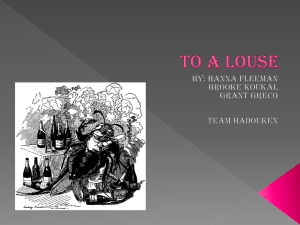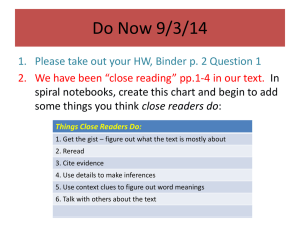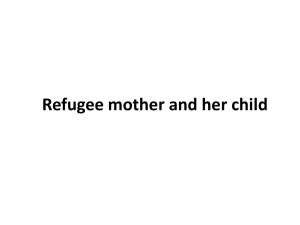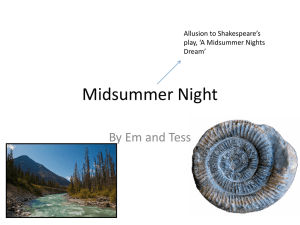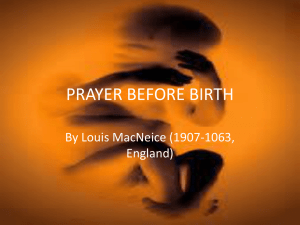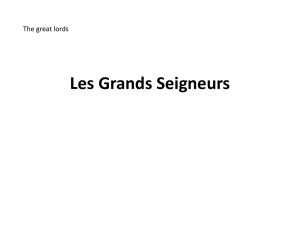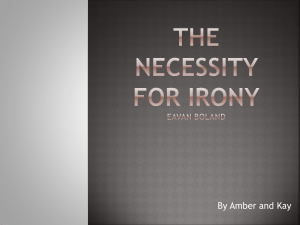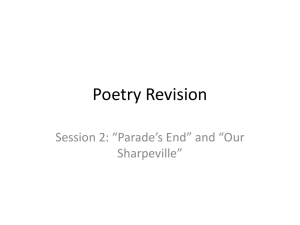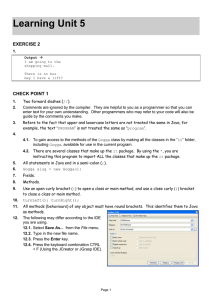File - Mrs. O`s Brit Lit Webpage
advertisement
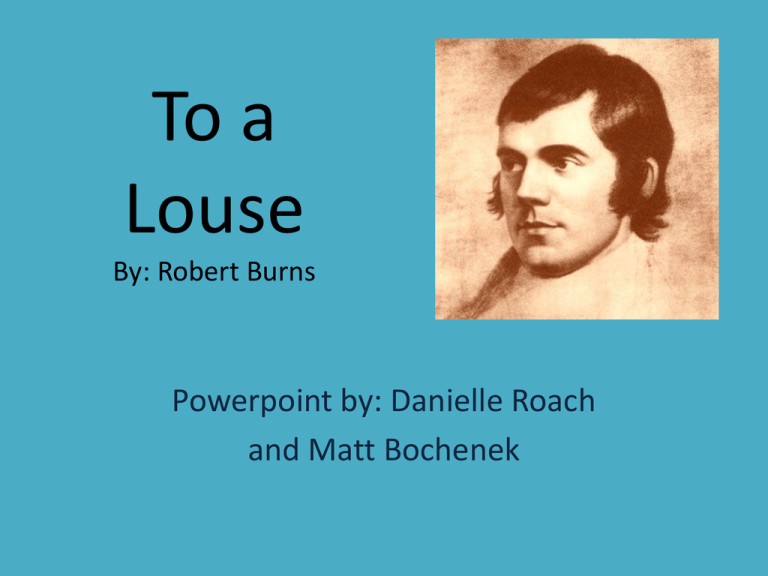
To a Louse By: Robert Burns Powerpoint by: Danielle Roach and Matt Bochenek Original Version: Translation: 1. 2. 3. 4. 5. 6. Ha! Whare ye gaun, ye crowlin ferlie? Your impudence protects you sairly, I canna say but ye strut rarely Owre gauze and lace, Tho' faith! I fear ye dine but sparely On sic a place. Ha! Where are you going, you crawling wonder? Your impudence protects you sorely, I can not say but you swagger rarely Over gauze and lace, Though faith! I fear you dine but sparingly On such a place. 7. 8. 9. 10. 11. 12. Ye ugly, creepin, blastit wonner, Detested, shunn'd by saunt an' sinner, How daur ye set your fit upon her -Sae fine a lady! Gae somewhere else and seek your dinner On some poor body. You ugly, creeping, blasted wonder, Detested, shunned by saint and sinner, How dare you set your foot upon her Such fine a lady! Go somewhere else and seek your dinner On some poor body. 13. 14. 15. 16. 17. 18. Swith! in some beggar's hauffet squattle: There you may creep, and sprawl, and sprattle Wi' ither kindred, jumping cattle, In shoals and nations; Whare horn nor bane ne'er daur unsettle Your thick plantations. Off! in some beggar's temples squat: There you may creep, and sprawl, and scramble, With other kindred, jumping cattle, In shoals and nations; Where horn nor bone never dare unsettle Your thick plantations. Imagery: Original Version: Translation: 19. 20. 21. 22. 23. 24. Now haud you there! ye're out o' sight, Below the fatt'rils, snug an' tight; Na, faith ye yet! ye'll no be right, Till ye've got on it --The vera tapmost, tow'ring height O' miss's bonnet. Now hold you there! you are out of sight, Below the falderals, snug and tight; No, faith you yet! you will not be right, Until you have got on it --The very topmost, towering height Of misses bonnet. 25. 26. 27. 28. 29. 30. My sooth! right bauld ye set your nose ou As plump an' grey as onie grozet: O for some rank, mercurial rozet, Or fell, red smeddum, I'd gie ye sic a hearty dose o't, Wad dress your droddum! My sooth! right bold you set your nose out, As plump and gray as any gooseberry: O for some rank, mercurial resin, Or deadly, red powder, I would give you such a hearty dose of it, Would dress your breech! 31. 32. 33. 34. 35. 36. I wad na been surpris'd to spy You on an auld wife's flainen toy: Or aiblins some bit duddie boy, On's wyliecoat; But Miss's fine Lunardi! fye! How daur ye do't. I would not have been surprised to spy You on an old wife's flannel cap: Or maybe some small ragged boy, On his undervest; But Miss's fine balloon bonnet! fye! How dare you do it. Diction Original Version: Translation: 37. 38. 39. 40. 41. 42. O Jenny, dinna toss your head, An' set your beauties a' abread! You little ken what cursed speed The blastie's makin! Thae winks an' finger-ends, I dread, Are notice takin'! O Jenny do not toss your head, And set your beauties all abroad! You little know what cursed speed The blastie's making! Those winks and finger-ends, I dread, Are notice takiing! 43. 44. 45. 46. 47. 48. O wad some Power the giftie gie us To see oursels as ithers see us! It wad frae monie a blunder free us, An' foolish notion: What airs in dress an' gait wad lea'e us, An' ev'n devotion! O would some Power the gift to give us To see ourselves as others see us! It would from many a blunder free us, And foolish notion: What airs in dress and gait would leave us, And even devotion! Imagery: Literal Sense of Poem • Stanza 1: He sees the louse crawling around and can’t believe it is so proud or that it is dining on such a fine person. • Stanza 2: He describes the louse and is disgusted by it and again cannot believe it is on such a fine lady. • Stanza 3: He says the louse ought to be on a beggar. • Stanza 4: The louse ought to stay out of sight but it won’t be happy until it is on the top of her bonnet. • Stanza 5: The louse sticks its nose out and the poet says how much he would like to kill it. Literal Sense of Poem • Stanza 6: He says he wouldn’t be surprised to find it on an old woman’s hat or on a young boy but how dare it be on this pretty young lady. • Stanza 7: We find out he knows the girl because he calls her by name. He doesn’t want her to shake her head because the lice will move and people will see them and begin laughing at her. • Stanza 8: He makes his point that it would be great if we could see ourselves as others see us. That even though we may dress nice or act superior others may see things that contradict the images we hope to put out there. Diction • The poem is writing in colloquial, it is concrete, vague, and in Scottish slang. • In line 19, the author uses vivid word order to express his want for the bug to stay still and out of sight. In line 26, the author also uses vivid word order to express how the louse looks. Also in line 33, the author uses vivid word order to express how the louse was bothering a young boy. Slide 3 Tone and Mood • Robert Burns does a good job of portraying a very stern and straight forward attitude in this poem. • Burns does include some humor, but can easily change the mood back to serious when needed. • The mood throughout the poem was melancholy and angry. • It is ironic that Robert Burns is slandering the louse when in the end he uses it to teach a lesson about the upper class. • This poem was meant to make the readers think about the social differences in society. Rhetorical Situation • Robert Burns is speaking to the louse, and stressing how the louse is a free loader. The louse bounces all over the lady taking what he needs. • The reader overhears the conversation in the poet’s head between him and the louse and we learn the lesson Burns learns from watching this scene. Figurative Language Simile: My sooth! right bauld ye set your nose ou As plump an' grey as onie grozet This is an example of a simile the author is comparing the louse to a gooseberry. You can picture the bug being plump and round. Personification: There you may creep, and sprawl, and sprattle Your impudence protects you sairly, I canna say but ye strut rarely He gives the louse credit for things it doesn’t/can’t do. It can’t be impudent and it doesn’t strut, creep or sprawl. Imagery: • The imagery used in this poem creates a mental image of a a dirty louse is crawling around on someone in church. – This can be visualized in line 14; you can visualize the louse creeping and crawling around. Slide 2 • Through the words of this poem you hear anger in the author’s voice. You can also see the louse crawling around. • The whole poem is a symbol of upper-class society vesrsus lower-class society. In line 41, the “winks and finger-ends,” symbolized others in church who begin talking or laughing about her situation. The louse symbolizes how little things can bring even those who think themselves better or see themselves as one way can be viewed by others as not being that way. The girl thought she looked pretty but she had a dirty louse on her. Slide 4 • The poem does rhyme. The 2nd, 3rd, and 5th stanza rhyme with each other. • Line 8, Line 14, and Line 23 both contain alliteration within the lines. ‘ – Line 8: Saint and sinner. – Line 14: sprawl and sprattle. – Line 23: tapmost and towering • Line 2 and 3 contains an assonance, sairly and rarely. • These effects are cacophony. • This poem is structured with stanzas each containing 6 lines. • Yes there is a rhyme pattern. For example in stanza 1: – – – – – – Ha! Whare ye gaun, ye crowlin ferlie? Your impudence protects you sairly, I canna say but ye strut rarely Owre gauze and lace, Tho' faith! I fear ye dine but sparely On sic a place. A A B C B C
